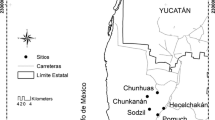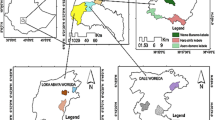Abstract
Our study examined the species composition and vegetative structure of traditional homegardens within the context of the surrounding land use mosaic typical of village lands in the southwest region of Sri Lanka. We conducted interviews and spatially mapped the land uses of a single traditional village comprising over thirty households. After mapping the different land uses for each household we selected ten households and conducted a census of the vegetation of their land use areas. Land use categories included homegarden, patio, rubber, tea plantation, and secondary forest and scrub. Land holdings varied in size between 0.18 and 1.34 hectares and comprised 39% tea land, 27% homegarden, 12% patio, 17% secondary forest and scrub land, and 4% rubber plantation. We identified a total of 268 plant species on the ten properties in a total of 216 genera and 84 families across all growth habits combined (trees, shrubs, herbs and climbers). Our results show three times the plant species richness in homegardens than for any similar research on tree gardens elsewhere, but a large proportion are exotic and almost all have some kind of utilitarian purpose. The top three tree species are palms in homegardens which represent over two-thirds of the stem density and half the basal area. The conservation activities within tree gardens emphasizes the crucial—but perhaps undervalued—role local livelihoods and land management activities play in retaining tree species diversity comparable but dramatically differing in taxa as compared to the original rain forest.





Similar content being viewed by others
References
Ali A, Mattsson E (2017a) Individual tree size inequality enhances aboveground biomass in homegarden agroforestry systems in the dry zone of Sri Lanka. Sci Total Environ 575:6–11
Ali A, Mattsson E (2017b) Disentangling the effects of species diversity, and intraspecific and interspecific tree size variation on aboveground biomass in dry zone homegarden agroforestry systems. Sci Total Environ 598:38–48
Ashton M, Gunatilleke S, de Zoysa N, Gunatilleke N, Wijesundera S (1997) A field guide to the common trees and shrubs of Sri Lanka. Wildlife Heritage Trust, Colombo, p 432
Aye YY, Pampasit S, Umponstira C, Thanacharoenchanaphas K, Sasaki N (2014) Floristic diversity, composition and stand structure of tropical forests in Pompa Mountain Park. J Environ Prot 5:1588–1602
Bardhan S, Jose S, Biswas S et al (2012) Homegarden agroforestry systems: an intermediary for biodiversity conservation in Bangladesh. Agrofor Syst 85:29–34. https://doi.org/10.1007/s10457-012-9515-7
Brearley FQ, Prajadinata S, Kidd PS, Proctor J (2004) Structure and floristics of an old secondary rain forest in Central Kalimantan, Indonesia, and a comparison with adjacent primary forest. For Ecol Manag 195:385–397
Caron CM (1995) The role of nontimber tree products in household food procurement strategies: profile of a Sri Lankan village. Agrofor Syst 32:99–117. https://doi.org/10.1007/BF00711567
Ediriweeera S, Singhakumara BMP, Ashton MS (2008) Variation in light, soil nutrition and soil moisture in relation to forest structure within a Sri Lankan rain forest landscape. For Ecol Manag 256:1339–1349
FAO (2009) Sri Lanka Forestry Outlook Study. Asia Pacific Forestry Outlook Sector Outlook Study II, Working Paper No. APFSOS II/WP/2009/29, Bangkok, FAO Regional Office for Asia and the Pacific
Fernandes E, Nair P (1986) An evaluation of the structure and function of tropical homegardens. Agric Syst 21:279–310. https://doi.org/10.1016/0308-521X(86)90104-6
Galhena DH, Freed R, Maredia KM (2013) Home gardens: a promising approach to enhance household food security and wellbeing. Agric Food Secur 2:8
Galluzzi G, Eyzaguirre P, Negri V (2010) Home gardens: neglected hotspots of agro-biodiversity and cultural diversity. Biodivers Conserv 19:3635–3654
Gliessman SR (1990) Agroecology: researching the ecological basis for sustainable agriculture. In Agroecology (pp. 3–10). Springer, New York
Gunatilleke C, Gunatilleke I (1985) Phytosociology of Sinharaja—a contribution to rain forest conservation in Sri Lanka. Biol Conserv 31:21–40
Gunatilleke IAUN, Gunatilleke CVS (1990) Distribution of floristic richness and its conservation in Sri Lanka. Conserv Biol 4:21–31
Gunatilleke CVS, Gunatilleke IAUN, Esufali S, Harmes KE, Ashton PMS, Burslem DFRP, Ashton PS (2006) Species-habitat associations in a Sri Lankan dipterocarp forest. J Trop Ecol 22:343–356
Ishwaran N, Erdelen W (1990) Conserving sinharaja: an experiment in sustainable development in SriLanka. Ambio 237–244
Jaccard P (1901) Étude comparative de la distribuition florale dans une portion des Alpes et des Jura. Bull Soc Vandoise Sci Nat 37:547–579
Jacob VJ, Alles WS (1987) Kandyan gardens of Sri Lanka. Agrofor Syst 5:123–137. https://doi.org/10.1007/BF00047517
Kabir ME, Webb EL (2008) Can homegardens conserve biodiversity in Bangladesh? Biotropica 40:95–103. https://doi.org/10.1111/j.1744-7429.2007.00346.x
Kehlenbeck K, Maass BL (2004) Crop diversity and classification of homegardens in Central Sulawesi, Indonesia. Agrofor Syst 63:53–62. https://doi.org/10.1023/B:AGFO.0000049433.95038.25
Kumar BM, Nair P (2004) The enigma of tropical homegardens. Agrofor Syst 61:135–152
Kumar BM, George SJ, Chinnamani S (1994) Diversity, structure and standing stock of wood in the homegardens of Kerala in peninsular India. Agrofor Syst 25:243–262. https://doi.org/10.1007/BF00707463
Kumari MAS, Kansuntisukmongkol K, Brockelman WY (2009) Plant diversity in home gardens and its contribution to household economy in suburban areas in Sri Lanka. Environ Nat Resour J 7:12–29
Lindara LMJK, Johnsen FH, Gunatilake HM (2006) Technical efficiency in the spice based agroforestry sector in Matale district, Sri Lanka. Agrofor Syst 68:221–230
Marsh R (1998) Building on traditional gardening to improve household food security. Food Nutr Agric, FAO, pp 4–14
Michon G, Mary F (1994) Conversion of traditional village gardens and new economic strategies of rural households in the area of Bogor, Indonesia. Agrofor Syst 25:31–58
Mohri H, Lahoti S, Saito O et al (2013) Assessment of ecosystem services in homegarden systems in Indonesia, Sri Lanka, and Vietnam. Ecosyst Serv 5:124–136. https://doi.org/10.1016/j.ecoser.2013.07.006
Navalkha C (2018) Agroforestry bolsters biodiversity and villages in Sri Lanka. Mongabay.com/Global Agroforestry. https://news.mongabay.com/2018/03/agroforestry-bolsters-biodiversity-and-villages-in-sri-lanka/
Oksanen J, Guillaume-Blanchet F, Friendly M, et al (2016) vegan: Community Ecology Package. R package version 2.4-1
Oliver CD, Larson BC (1996) Forest stand dynamics: updated edition. Wiley
Perera AH, Rajapakse R (1991) A baseline study of Kandyan forest gardens of Sri Lanka: structure, composition and utilization. For Ecol Manag 45:269–280. https://doi.org/10.1016/0378-1127(91)90222-H
Peyre A, Guidal A, Wiersum KF, Bongers F (2006) Dynamics of homegarden structure and function in Kerala, India. Agrofor Syst 66:101–115. https://doi.org/10.1007/s10457-005-2919-x
Pushpakumara DKNG, Marambe B, Silva GLLP et al (2012) A review of research on homegardens in Sri Lanka: the status, importance a future perspective. Trop Agric 160:55–125
R Core Team (2016) R: A language and environment for statistical computing
Rasingam L, Parathasarathy N (2009) Tree diversity and forest structure across major forest formations and disturbance categories of little Andaman Island, India. Trop Ecol 50:89–102
Sahunalu P, Dhanmanonda P, Puriyakorn B, Jamroenprucksa M, Suwannapinunt W, Prachaiyo B (1979) Comparative strutural characteristics of three forest types at Namprom Basin, Chaiyaphoom Province (Th.). For Res Bull 63:25–33
Sangakkara UR, Frossard E (2016) Characteristics of South Asian rural households and associated homegardens—a case study from Sri Lanka. Trop Ecol 57:765–777
Senanayake RL, Sangakkara UR, Pushpakumara D, Stamp P (2009) Vegetation composition and ecological benefits of home gardens in the Meegahakiula Region of Sri Lanka. Trop Agric Res. https://doi.org/10.4038/tar.v21i1.2581
Varghese AO, Balasubramanyan K (1999) Structure, composition and diversity of the tropical wet evergreen forest of the Agasthyamalai region of Kerala, Western Ghats. J. South Asian Nat. Hist 14:87–134
Weerahewa J, Pushpakumara G, Silva P (2012) Are homegarden ecosystems resilient to climate change? An analysis of the adaptation strategies of homegardeners in Sri Lanka. APN Sci Bull 2:22–27
Weersum KF (1982) Tree gardening and taungya on Java: examples of agroforestry techniques in the humid tropics. Agrofor Syst 1:53–70
Wiersum KF (2006) Diversity and change in homegarden cultivation in Indonesia. In: Tropical Homegardens (pp. 13–24). Springer, Netherlands
Wilkie P, Argent G, Cambell E, Saridan A (2004) The diversity of 15 ha of lowland mixed dipterocarp forest, Central Kalimantan. Biodivers Conserv 13:695–708
Acknowledgements
This study was done with funding and support from the Tropical Resources Institute of the School of Forestry and Environmental Studies, Yale University. We also thank the Sri Lanka Program for Forest Conservation and the Sri Lanka Forest Department for technical and logistical support.
Author information
Authors and Affiliations
Corresponding author
Rights and permissions
About this article
Cite this article
Martin, M., Geiger, K., Singhakumara, B.M.P. et al. Quantitatively characterizing the floristics and structure of a traditional homegarden in a village landscape, Sri Lanka. Agroforest Syst 93, 1439–1454 (2019). https://doi.org/10.1007/s10457-018-0254-2
Received:
Accepted:
Published:
Issue Date:
DOI: https://doi.org/10.1007/s10457-018-0254-2




